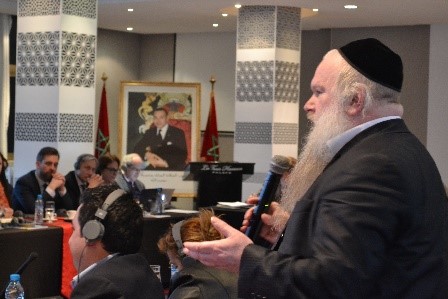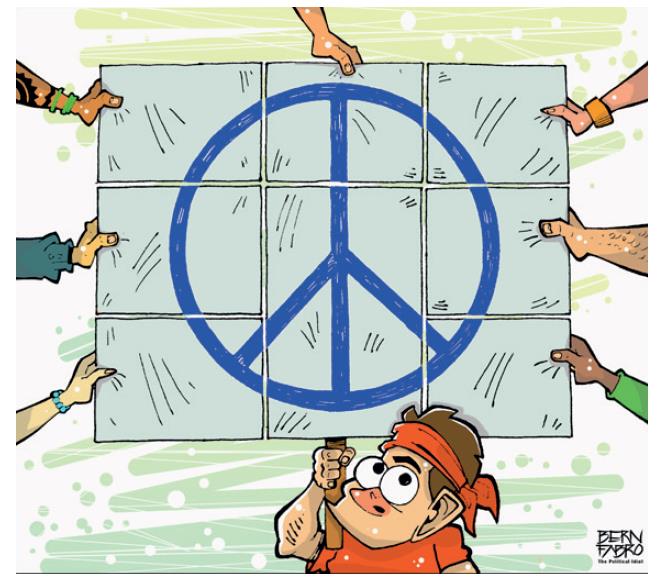Module 17: Research, documentation and exchange
#Faith4Rights toolkit
Full text of commitment XVII
| We commit to support each other at the implementation level of this declaration through exchange of practices, mutual capacity enhancement and regular activities of skills updating for religious and spiritual preachers, teachers and instructors, notably in areas of communication, religious or belief minorities, inter-community mediation, conflict resolution, early detection of communal tensions and remedial techniques. In this vain, we shall explore means of developing sustained partnerships with specialised academic institutions so as to promote interdisciplinary research on specific questions related to faith and rights and to benefit from their outcomes that could feed into the programmes and tools of our coalition on Faith for Rights. |
Context
This commitment is at the heart of the #Faith4Rights peer-to-peer learning approach. Nothing is more inspiring than success stories in real-life situations, including the most local and grassroots ones. Strangely enough, very few of the national and international efforts dedicate sufficient attention to compiling and spreading innovative practices in the field of human rights responsibilities of faith actors. There is plenty of information about general policy statements but much less on concrete projects. Even less attention has been paid to the research areas associated with faith actors’ engagement. Modern communication technologies should facilitate knowledge management, including a database of actors, actions, results and lessons learned about the role of faith actors with respect to human rights and their corresponding Sustainable Development Goals. Partnership with research institutions across the globe could fill an important knowledge gap that needs to be adapted for faith actors.
Additional supporting documents
Since 2010, the United Nations Inter-Agency Task Force on Religion and Sustainable Development has been engaging with faith-based actors. In order to leverage partnerships, the UN Strategy and Plan of Action on Hate Speech (2019) includes the following key UN commitment: “The UN should establish/strengthen partnerships with relevant stakeholders, including those working in the tech industry. Most of the meaningful action against hate speech will not be taken by the UN alone, but by governments, regional and multilateral organizations, private companies, media, religious and other civil society actors.”
Peer-to-peer learning exercises
Unpacking: Participants break down commitment XVII into different elements. They identify its explicit and implicit actionable points. Participants define who should be responsible for which action and relevant stakeholders in their own environments who would be best placed to support faith actors’ endeavours to optimize the moral weight of religion or belief in defending human dignity in all areas on which faith actors choose to engage. (individual exercise for five minutes followed by ten minutes of full-group discussion on the differences between individual listings).
Linking the dots: This commitment provides another demonstration of the indivisibility of human rights and the corresponding interdependence among the 18 commitments on “Faith for Rights”. Mutual support among faith actors who advocate “Faith for Rights” is a cross-cutting commitment. Two key words are partnerships and capacity-building. The intersectionality between these two areas is obvious. Its translation into concrete projects would benefit from a discussion among participants, linking them notably to commitments III, VI, VII and XII (collective exercise for ten minutes).
Critical thinking: A critical discussion on the relationship between these elements could also focus on which areas of research would be useful to strengthen the role of faith actors in implementing the 18 commitments on “Faith for Rights”. Which academic centres could be interested in and capable of supporting their plans of action? Do participants agree on the need for sustainable knowledge updates and capacity development? Have any of the participants attended any related events or programmes of inter-faith collaboration? What benefit did they gain from such events or programmes? What do participants believe could be missing in the efforts deployed to this effect, both nationally and internationally? Can participants define their own needs in terms of capacity development and fundraise for its implementation? Are there missing elements in that commitment? (Collective exercise for 20 minutes)
Tweeting: Summarize the commitment XVII within 140 characters (Individual exercise for five minutes). One possible result of this tweeting exercise could be as follows: “We commit to develop sustained partnerships with specialised academic institutions to promote interdisciplinary research, programs and tools for implementing the 18 commitments”.
Translating: Similar to the tweeting exercise, participants could be asked to “translate” this commitment into child-friendly language or into a local dialect. Again the idea is to stimulate discussion about the most important elements and appropriate ways of transposing and simplifying the message, without losing the substance of the commitment.
Storytelling: Participants share relevant situations they have witnessed in relation to this commitment and what they concluded from such an experience. In particular, how can best practices be exchanged in the areas of training and outreach with respect to religious minorities, inter-community mediation, conflict resolution, early detection of communal tensions and remedial techniques? Did participants undertake their own research to find by themselves for information on best practices that would support their work? How did they proceed with their search for resources and how do they evaluate the results? What is it that would make this task easier for them in future? (Collective exercise for 15 minutes)
 Facilitators could also refer, as an example of innovative awareness raising, to the 2019 report of the Special Rapporteur on freedom of religion or belief, Ahmed Shaheed, with a thematic focus on combating antisemitism: “In Sweden, the Living History Forum, a public body, produces educational exhibition material and materials for the classroom on democracy and human rights and uses the Holocaust and other crimes against humanity as a starting point. Many States provide Holocaust education in schools. However, the Special Rapporteur notes the concern among many stakeholders that Holocaust education is not enough to effectively teach people to recognize and respond to antisemitism. Empathy training, religious education and modern images of Jews should be promoted through education for children.”
Facilitators could also refer, as an example of innovative awareness raising, to the 2019 report of the Special Rapporteur on freedom of religion or belief, Ahmed Shaheed, with a thematic focus on combating antisemitism: “In Sweden, the Living History Forum, a public body, produces educational exhibition material and materials for the classroom on democracy and human rights and uses the Holocaust and other crimes against humanity as a starting point. Many States provide Holocaust education in schools. However, the Special Rapporteur notes the concern among many stakeholders that Holocaust education is not enough to effectively teach people to recognize and respond to antisemitism. Empathy training, religious education and modern images of Jews should be promoted through education for children.”
Responding to pandemics: During a panel discussion on multi-stakeholder action to address COVID-19 (December 2020), High Commissioner Michelle Bachelet stressed: “The current crisis is one of public health that requires awareness, compassion and solidarity; faith actors are uniquely well placed to promote these values that are more needed than ever. And I think that such actions are particularly compelling if various faith actors join their hands and hearts in an inter-faith manner. Let me give you a recent example of such interfaith support: A Lutheran church in Berlin has hosted Muslim worshippers who were unable to take part in Friday prayers at their mosque because of social distancing rules. So the Imam led prayers in German and Arabic, stressing that the pandemic has brought people together. The church's pastor was moved by the Muslim call to prayer in the church and she said that ‘we have the same concerns and we want to learn from you. And it is beautiful to feel that way about each other.’ I would like to emphasize the powerful image of a male imam and a female pastor praying together and acting in solidarity.”
Exploring: Participants could be asked, in a collective discussion or in small groups, to define elements for a partnership project with a hypothetical academic centre that is specialized in producing short documentaries for educational purposes. What would be the list of topics and the features of the documentaries that participants would request to produce and why? What skills would be needed to promote an interdisciplinary understanding of specific questions related to faith and rights in the particular contexts where participants practice their faith functions? (Discussion in working groups for 30 minutes, followed by presentation of the project proposals in plenary, depending on time frame and objectives of the peer-to-peer learning).

 Adding faith quotes: Participants search religious or belief quotes pertinent to commitment XVII (individual exercise for five minutes, followed by a reading from each participant of his or her added reference and a telegraphic explanation of its added value to deepen the commitment under consideration).
Adding faith quotes: Participants search religious or belief quotes pertinent to commitment XVII (individual exercise for five minutes, followed by a reading from each participant of his or her added reference and a telegraphic explanation of its added value to deepen the commitment under consideration).
Inspiring: Participants share artistic expressions they know of that capture aspects of the commitment under discussion. In this context, the facilitator could refer to the documentary series “Believe to See”, which showcases the beliefs, philosophies and teachings of 12 spiritual leaders from across the globe. The TV series was created by Gaby Herbstein, an Argentina-based photographer, who wanted to show that while belief systems and cultures may be different, they share messages of dignity and equal rights of all human beings. “I think that change in the world will come from spirituality,” she said. “For my documentary series, I have travelled to Argentina, Austria, Greenland, Malta, Mexico, India, Russia and the United States to meet with spiritual leaders and participate in their ceremonies.” The series features not only leaders from the major religions but also indigenous faith leaders, offering their own words of inspiration. The series was scheduled for release earlier than June 2020, but the COVID-19 pandemic pushed back broadcast. Herbstein said the pandemic has only sharpened the need for and message of the series. “This is a bridge. Believe to See is a project about believing in ourselves. It’s a project about ‘unity in diversity’, where people will realize that all those teachers, elders and spiritual leaders are saying in different languages and with different tools the same thing. They help us to remember that everything is already within us.”
Learning objectives
- Participants appreciate the value for their own purposes, of empirical evidence, statistical data and other means of social observation methodologies.
- Participants develop the reflex of not reinventing the wheel but rather constantly seeking the wisdom of ideas and actions by other faith actors facing similar challenges.
- Participants acquire comparative experience emanating from best practices that should become a primary source of their inspiration. They know through this #Faith4Rights toolkit where to find and how to use data gathered by specialized non-state actors, academic institutions and relevant international agencies and mechanisms.
- Participants realize the extent of interdependence between all social forces and non-state actors to a point that makes building partnership a condition for progress.
- Participants are convinced that faith actors too need to build coalitions, both among themselves and with other actors within their areas of common interest.
previous module ¦ overview ¦ next module >